Introduction
In the rapidly evolving landscape of cloud computing, Amazon Aurora Multi-Master emerges as a transformative solution that empowers organizations to optimize their database management strategies. This advanced feature enables the deployment of multiple database instances capable of executing concurrent read and write operations, significantly enhancing both availability and scalability.
By leveraging this innovative architecture, businesses can experience remarkable improvements in application performance, with reduced latency and increased throughput, making it an ideal choice for high-demand environments.
As enterprises grapple with the complexities of managing extensive workloads and ensuring uninterrupted service, understanding the intricacies of Aurora Multi-Master becomes essential.
This article delves into the setup, benefits, best practices, challenges, and real-world applications of Amazon Aurora Multi-Master, providing a comprehensive guide for developers and organizations looking to harness its powerful capabilities.
Introduction to Amazon Aurora Multi-Master
The feature of Amazon Aurora multi-master is a crucial aspect of its database, enabling organizations to implement several database units capable of performing concurrent read and write operations. This innovative architecture significantly enhances both availability and scalability, allowing businesses to optimize application performance and resilience. Leveraging Amazon Aurora Multi-Master capabilities enables developers to achieve remarkable throughput and reduced latency, as multiple instances concurrently process requests, thereby alleviating potential bottlenecks.
Notably, larger, more intensive queries perform up to 20x faster with Parallel Query turned on, further bolstering performance enhancements. This functionality, particularly with Amazon Aurora multi-master, is especially advantageous for applications subjected to heavy workloads and those that demand unwavering availability, effectively eliminating single points of failure. With Amazon's ability to replicate data across multiple Availability Zones, organizations can ensure their mission-critical applications remain operational even during peak traffic periods.
A notable example is Tuya Smart, which utilized a platform to manage billions of real-time online devices, successfully maintaining cloud message processing response times under 10 milliseconds while addressing the challenges posed by surges in simultaneous device connectivity during high-demand periods. Tuya chose Amazon's relational data service as the core engine for its unmatched performance and availability at a global scale. Furthermore, the auto-scaling features of Amazon's service promise to minimize operational risks, as evidenced by ISCS's strategic growth approach, which anticipates significant expansion in data size and throughput, seeking a reliable scaling strategy.
Grasping the intricacies of this architecture is essential for developers aiming to fully harness this sophisticated feature, paving the way for enhanced database management and operational excellence.
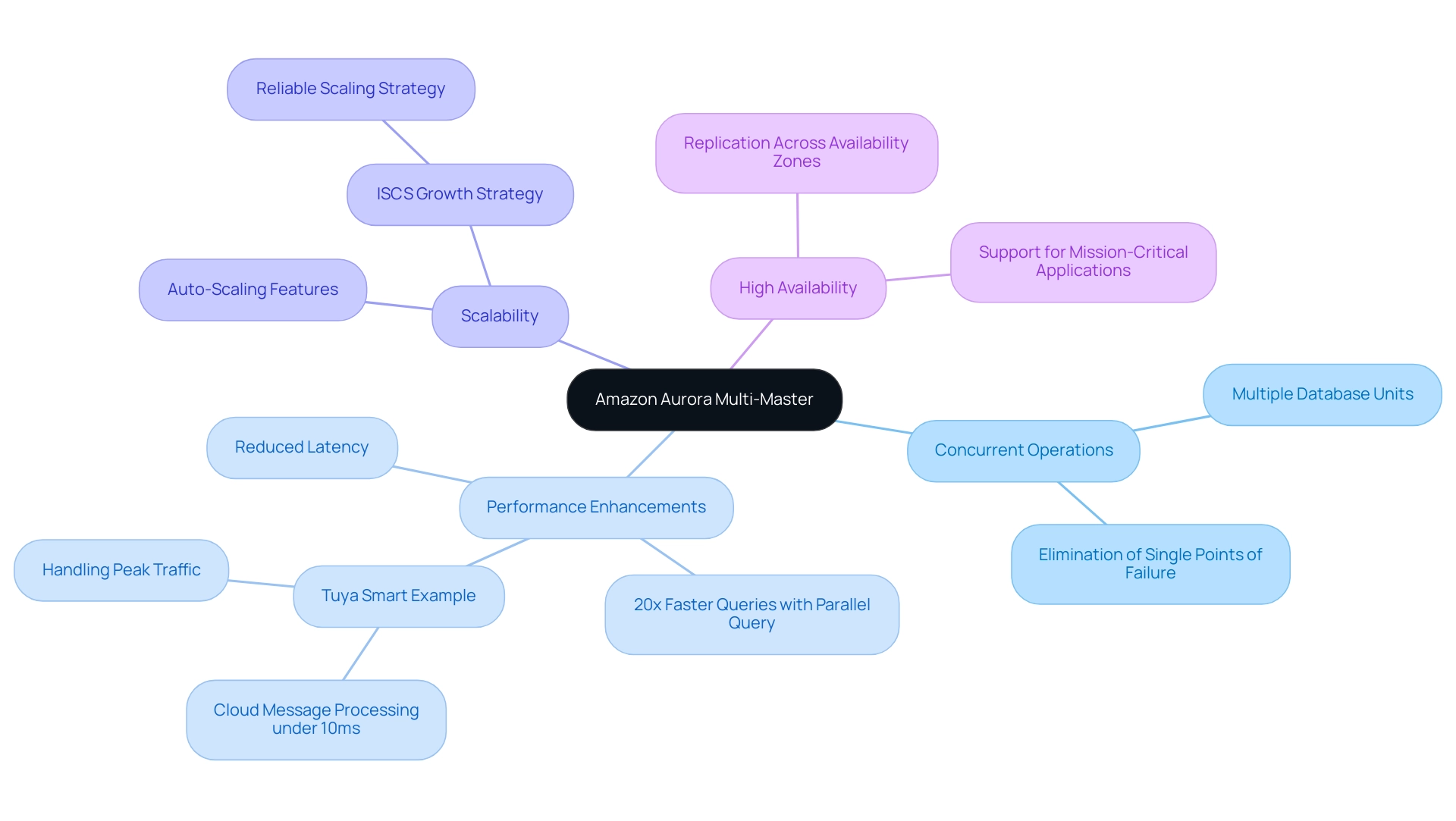
Setting Up and Configuring Amazon Aurora Multi-Master
To establish an Amazon Multi-Master setup, adhere to the following detailed steps:
-
Create an Amazon DB Cluster: Begin by accessing the AWS Management Console. Navigate to the RDS dashboard and choose 'Create data storage.' Opt for 'Amazon Aurora Multi Master' as your engine type and select it for the cluster configuration.
Configure Instance Settings: Specify the instance class and the number of instances required. Additionally, configure storage options and VPC settings. It is critical to select multiple availability zones to bolster fault tolerance and enhance reliability across your setup. -
Set Up Database Parameters: Adjust parameters such as DB parameter groups and option groups. This customization is essential for optimizing settings tailored to your application’s specific requirements.
Launch the Cluster: After reviewing your configurations for accuracy, proceed to launch the cluster. AWS will provision your configuration for Amazon Aurora Multi Master, which typically takes a few moments to finalize.
Connect to the Cluster: Once the cluster is operational, establish a connection using your preferred data management client. You will require the endpoint provided in the AWS Management Console to facilitate this connection. -
Testing Write Operations: To verify the functionality of Multi-Master, execute write operations across different database environments. This step is crucial for monitoring performance and ensuring your application efficiently manages concurrent writes.
-
Monitor and Optimize: Utilize AWS CloudWatch to track the performance metrics of your database instances. Ongoing enhancement of settings according to your usage trends is crucial for sustaining optimal performance.
It's essential to take into account the financial factors of your setup, especially that starting April 1, 2026, you will incur a fee of $0.200 per vCPU-hr for PostgreSQL-Compatible 11. By meticulously following these steps, developers can effectively set up and configure the Amazon Aurora Multi-Master system, thus harnessing its robust capabilities for enhanced data management.
As emphasized, TLE for PostgreSQL accesses your PostgreSQL database exclusively through the TLE API, ensuring secure and efficient communication throughout the process.
This API not only supports all functions of the PostgreSQL server programming interface but also enhances security. For example, the case study titled 'Communication of TLE Extensions with PostgreSQL Database' illustrates how TLE for PostgreSQL ensures secure communication through the API, reinforcing its importance in your setup.
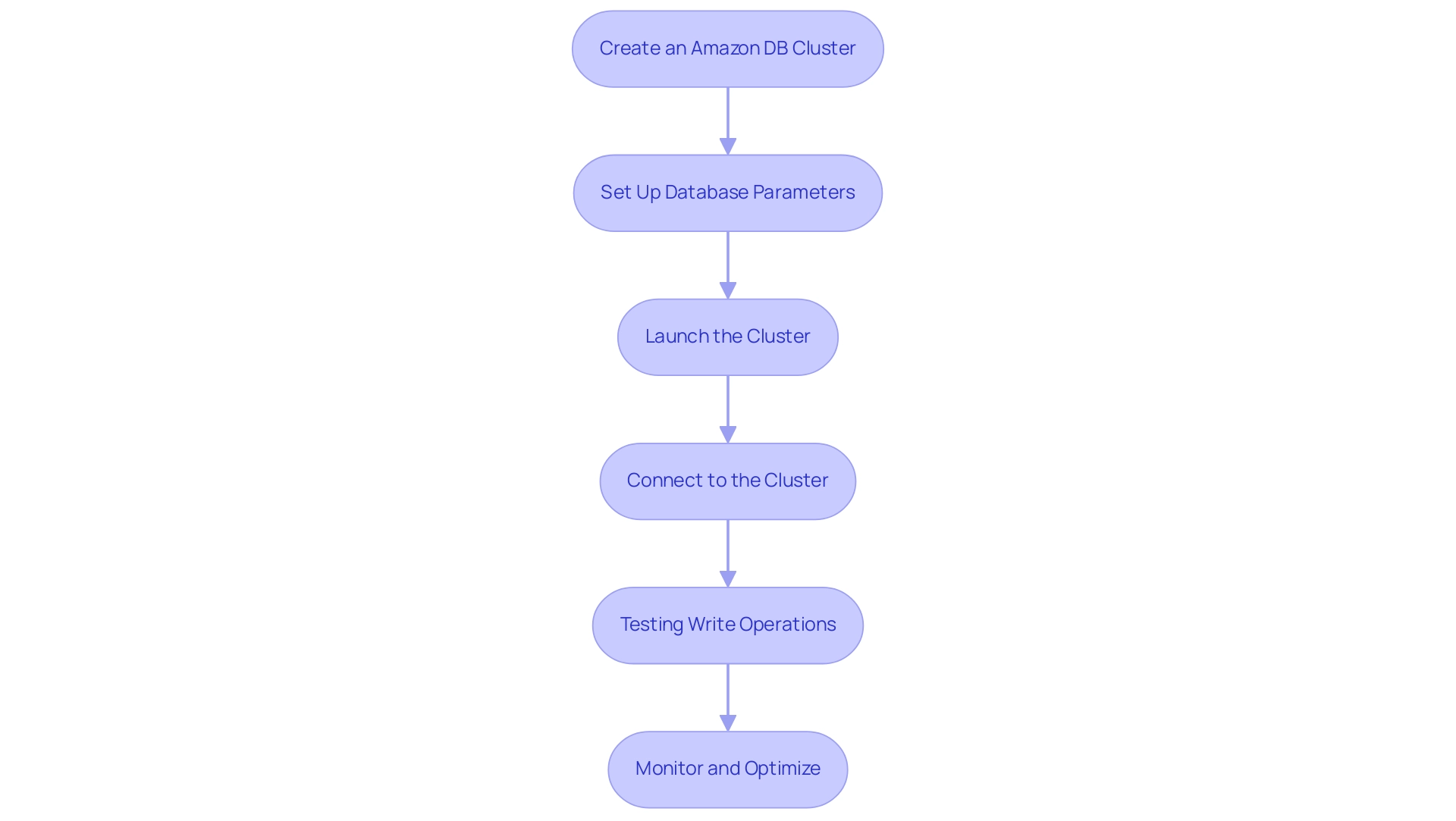
Understanding the Benefits of Multi-Master Configuration
Amazon Aurora Multi-Master presents a compelling suite of benefits that can significantly enhance application performance and reliability:
-
Enhanced Accessibility: The design of Amazon Aurora Multi-Master configurations significantly reduces the likelihood of interruptions. In scenarios where one occurrence encounters failure, other active occurrences seamlessly continue to process requests, thereby ensuring uninterrupted service delivery. Recent studies indicate a marked increase in uptime statistics among companies employing distributed systems, underscoring its effectiveness in enhancing availability.
-
Scalability: With the capability to add several primary nodes, multiple-master setups facilitate horizontal scaling. This flexibility allows organizations to efficiently manage increasing workloads without sacrificing performance, a critical feature as application demands grow. As highlighted by Sengwee Toh from Harvard Medical School, the use of real-world data in evaluating these configurations is essential for informed decision-making.
-
Improved Performance: By distributing both read and write operations across different units, applications benefit from accelerated response times and enhanced throughput. This operational efficiency is vital for delivering a superior user experience, especially during peak usage times. However, it is important to note that transitioning to a DBaaS solution like Amazon Aurora Multi-Master may introduce new architectural considerations that could initially affect performance, as indicated in the case study titled "Expect Things to be Slightly Slower."
-
Automatic Failover: The built-in automatic failover features within a multiple-master setup ensure that if one node becomes unavailable, traffic is rerouted to functioning nodes without interruption. This feature is essential for maintaining high availability standards in mission-critical applications.
-
Simplified Management: Utilizing AWS's managed services for Amazon Aurora Multi-Master significantly decreases the operational complexities related to database instance management. This reduction in overhead allows development teams to concentrate their efforts on application innovation rather than infrastructure concerns.
These advantages emphasize the importance of distributed configurations in enhancing application reliability and user satisfaction. Furthermore, industry experts emphasize that organizations implementing such architectures can anticipate enhancements in availability, with recent studies showing a significant rise in uptime statistics among companies employing distributed setups. As we approach 2024, the ongoing development of Amazon's database solution promises even greater scalability metrics and performance improvements, making it an essential factor for forward-thinking enterprises.
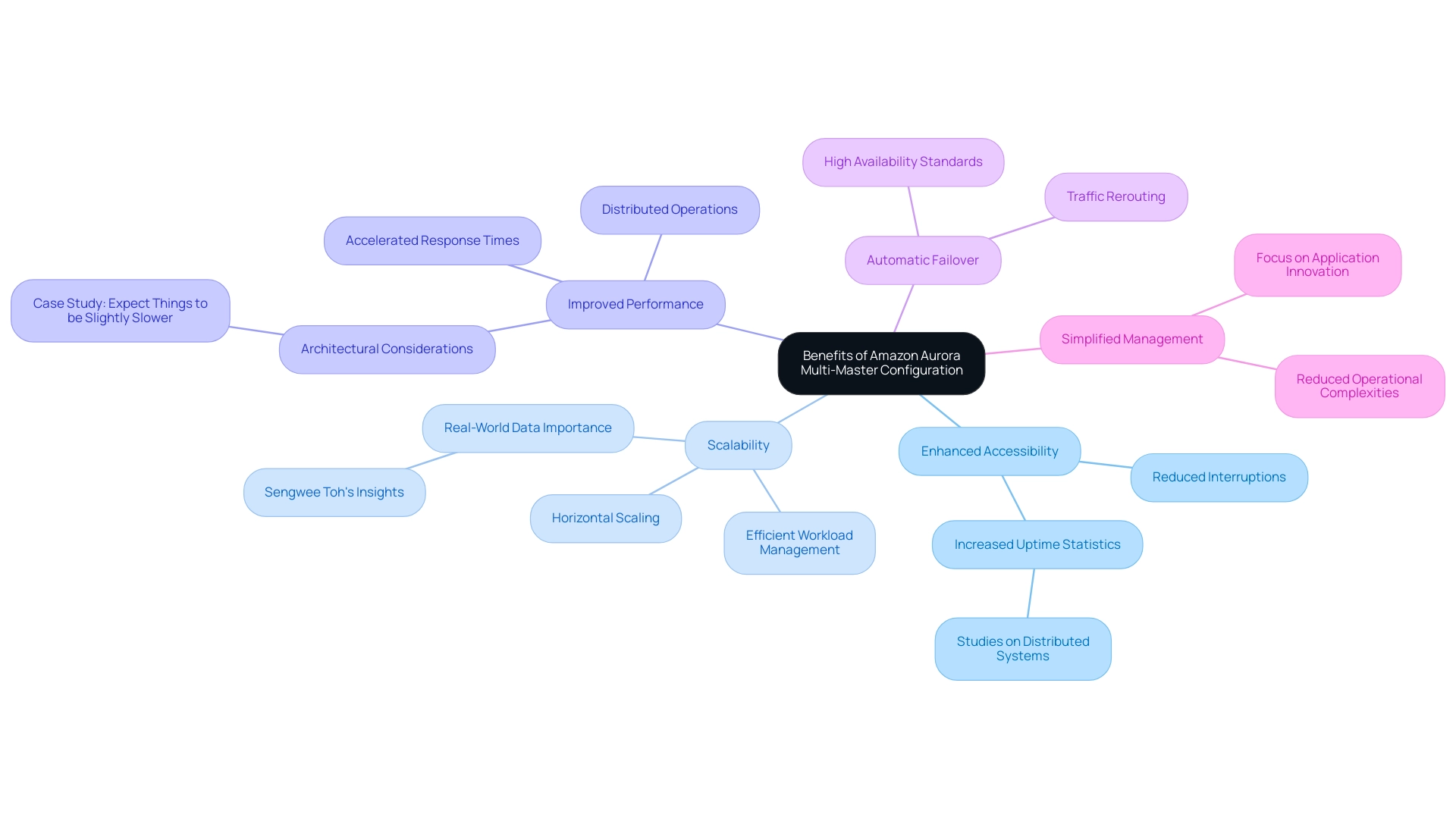
Best Practices for Working with Amazon Aurora Multi-Master
To maximize the effectiveness of Amazon Aurora Multi-Master, it is essential to adopt several best practices:
-
Design for Conflict Resolution: With the capability of multiple instances to handle write operations, it is imperative to design your application with robust conflict management strategies. Establish mechanisms to detect and resolve write conflicts effectively, ensuring data integrity and consistency across the system. As Sedat Salman, an expert in the field, points out, "Cluster endpoints are not used for DML in amazon aurora multi master setups," highlighting the importance of understanding the architecture of Multi-Master configurations.
-
Monitor Performance Metrics: Employ AWS CloudWatch to regularly monitor critical performance metrics of your data system. Focus on indicators such as CPU utilization, freeable memory, write operations, and latency to proactively identify and address performance bottlenecks. A customer utilizing a large RDS Aurora cluster with 12 replicas—comprised of 6x r5.12xlarge and 6x r5.4xlarge—benefits greatly from real-time monitoring to assess load and performance. Regularly evaluating these metrics is crucial for maintaining optimal performance.
-
Optimize Connection Management: Utilize connection pooling to efficiently manage connections, which minimizes the overhead associated with establishing new links. This optimization not only enhances application performance but also reduces resource consumption on the database side.
-
Regular Backups: Establish a regular backup schedule and utilize AWS's automated backup features to protect your data from unexpected failures. Testing backup restoration processes is crucial to ensure that your data can be reliably recovered when necessary.
-
Test Failover Scenarios: Conduct regular failover testing to validate that your application can seamlessly handle instance failures. This proactive approach prepares your team for real-world scenarios, ensuring operational continuity and reliability.
-
Test Parameter Group Changes: Before applying DB parameter group changes to production, it is advised to test these changes on a test DB cluster. This practice helps avoid performance degradation and system instability, reinforcing the importance of proactive measures in maintaining performance and stability.
By applying these best practices, developers can significantly improve the robustness and efficiency of their applications that utilize Amazon Aurora Multi Master, ultimately driving better performance and reliability.
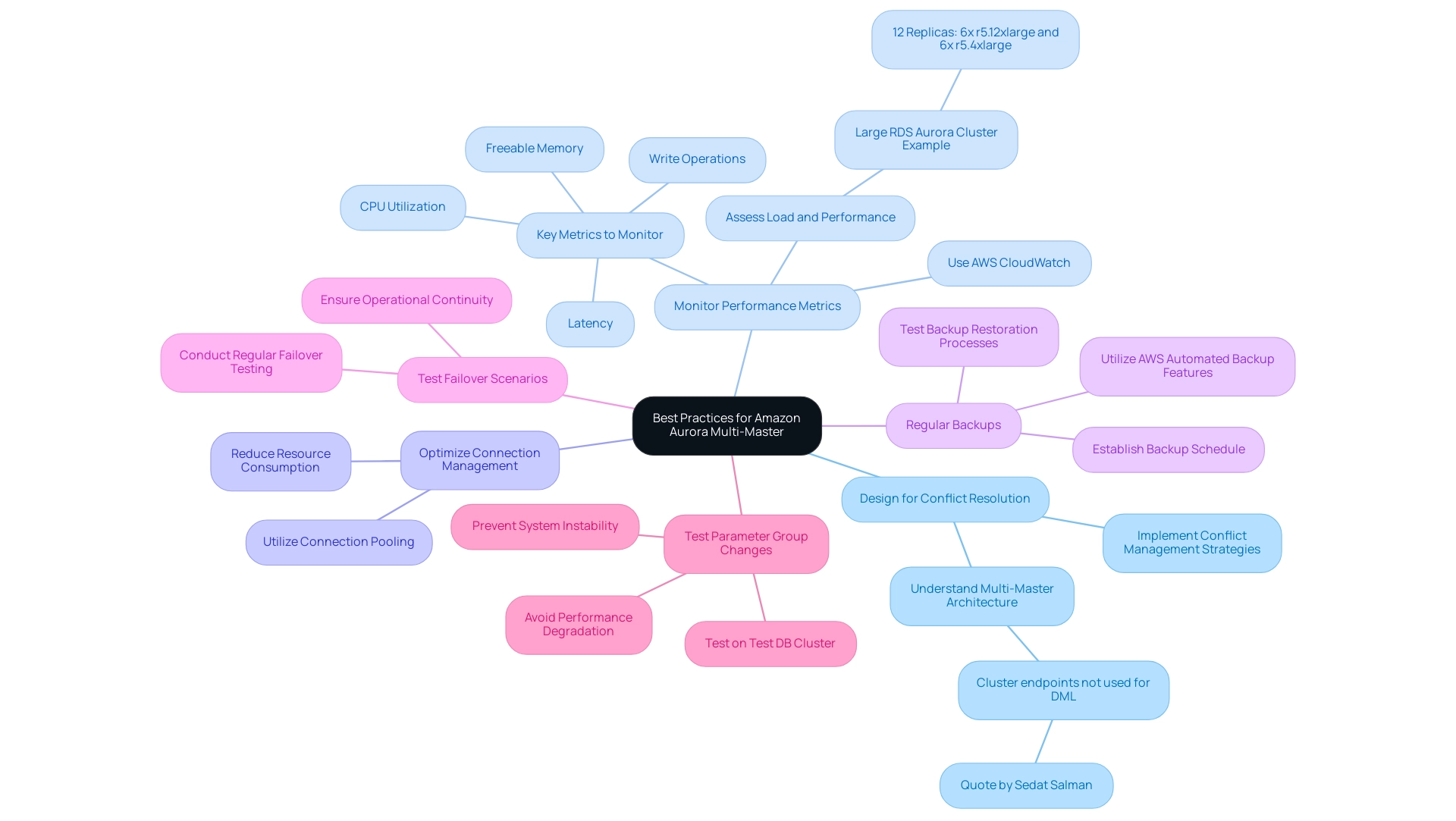
Common Challenges and Solutions
Implementing the Amazon Aurora Multi-Master setup presents several challenges that require careful consideration.
- Write Conflicts: The inherent risk of write conflicts increases with multiple master nodes, necessitating robust application design to handle such conflicts. Techniques such as versioning or timestamps can be instrumental in resolving these issues.
As noted by Ali Mirza,
The framework implemented in C#.Net was evaluated on two synthetically populated databases and successfully resolved the aforementioned conflicts.
This highlights the importance of strategic conflict management in maintaining data integrity. Additionally, the case study titled 'When to Resolve Conflict?' identifies critical points for injecting conflict resolution logic, emphasizing the timing of these interventions to optimize data integrity.
-
Increased Complexity: The introduction of multiple occurrences can significantly complicate your architectural framework. To mitigate this complexity, leverage AWS tools and thorough documentation, ensuring that management processes are streamlined and clarity is maintained within your setup.
-
Monitoring and Maintenance: The operational demands of overseeing multiple units can be substantial. Statistics show that log-warnings are printed every 120 seconds when they exceed one, highlighting the need for diligent monitoring. Utilizing AWS CloudWatch for real-time monitoring and setting up alerts for critical metrics will enable proactive management of your system's health, ensuring optimal performance.
-
Cost Considerations: The implementation of multiple master setups may lead to escalated costs due to the necessity of additional instances. It is essential to continuously evaluate usage patterns and optimize configurations to achieve a balance between performance and expenditure. Future work aims to explore additional data level conflicts and evaluate the system on real-world databases, including those utilizing Amazon Aurora Multi-Master, which underscores the ongoing developments and considerations in the field. Addressing these challenges proactively allows developers to facilitate a smoother implementation process, thereby ensuring high-performance applications and enhancing user experience.
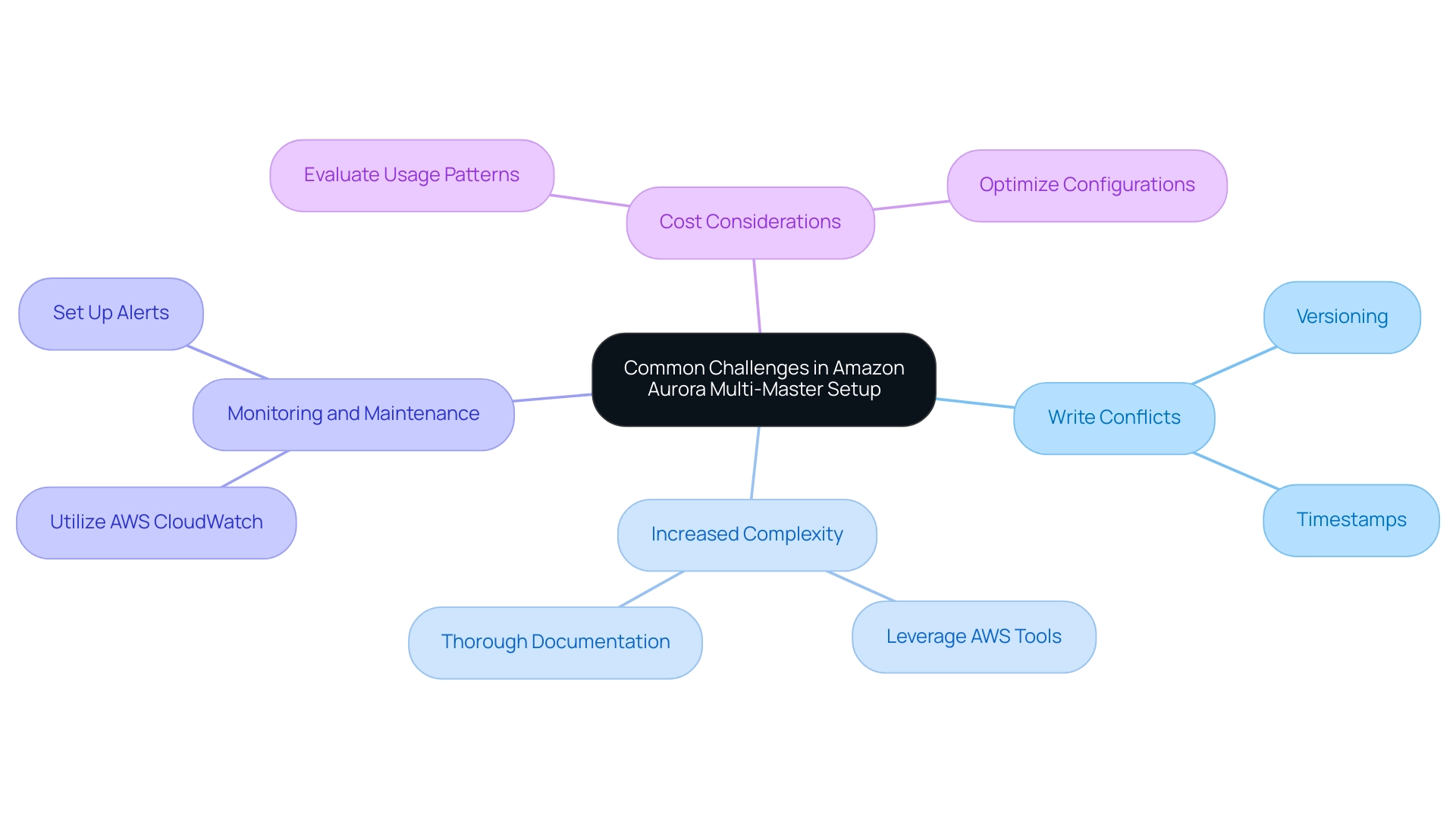
Real-World Use Cases for Amazon Aurora Multi-Master
Amazon's advanced database system is increasingly being utilized across various sectors, demonstrating its strong capabilities for diverse applications:
-
E-commerce Platforms: High-traffic e-commerce sites adopt configurations such as Amazon Aurora Multi Master to manage multiple simultaneous transactions without downtime. This ensures a seamless shopping experience, crucial for maintaining customer satisfaction and retention. Notably, migrating to Amazon Aurora has been shown to make payment processes 70% faster, significantly enhancing operational efficiency. Additionally, the use of temporary objects improves query processing by placing temporary tables on local storage, which is particularly beneficial for data-intensive operations.
-
Gaming Applications: In the realm of online gaming, platforms employ a multi-source approach to facilitate real-time data updates from players around the globe. This architecture minimizes latency and ensures that interactions remain fluid, even under high user loads. Performance metrics indicate that using AWS Graviton2-based instances can achieve peak loads around 85% for short durations, typically lasting 10 to 12 minutes, which is critical for maintaining game performance during peak play times, as noted by Site Reliability Engineer Alexios Polyzos.
-
Financial Services: Within the finance sector, Amazon Aurora Multi Master configurations are essential for maintaining high availability in transaction processing systems. They enable organizations to handle peak loads effectively, ensuring that critical operations remain uninterrupted during high-demand periods, which is vital for customer trust and compliance.
-
Content Management Systems: Media and content platforms utilize a distributed model to empower content creators to publish updates from various locations. This capability ensures that content remains fresh and current, allowing for timely engagement with audiences without delays.
These real-world applications underscore the versatility and power of Amazon Aurora Multi-Master, demonstrating its effectiveness in addressing the diverse needs of modern businesses. Furthermore, the recent integration of Aurora's zero-ETL process with Amazon Redshift enhances its utility, enabling near real-time analytics on transactional data without complex ETL processes. This integration ensures that transactional data is continuously replicated to Amazon Redshift, allowing immediate analysis and advanced features, thereby providing valuable insights that support data-driven decision-making.
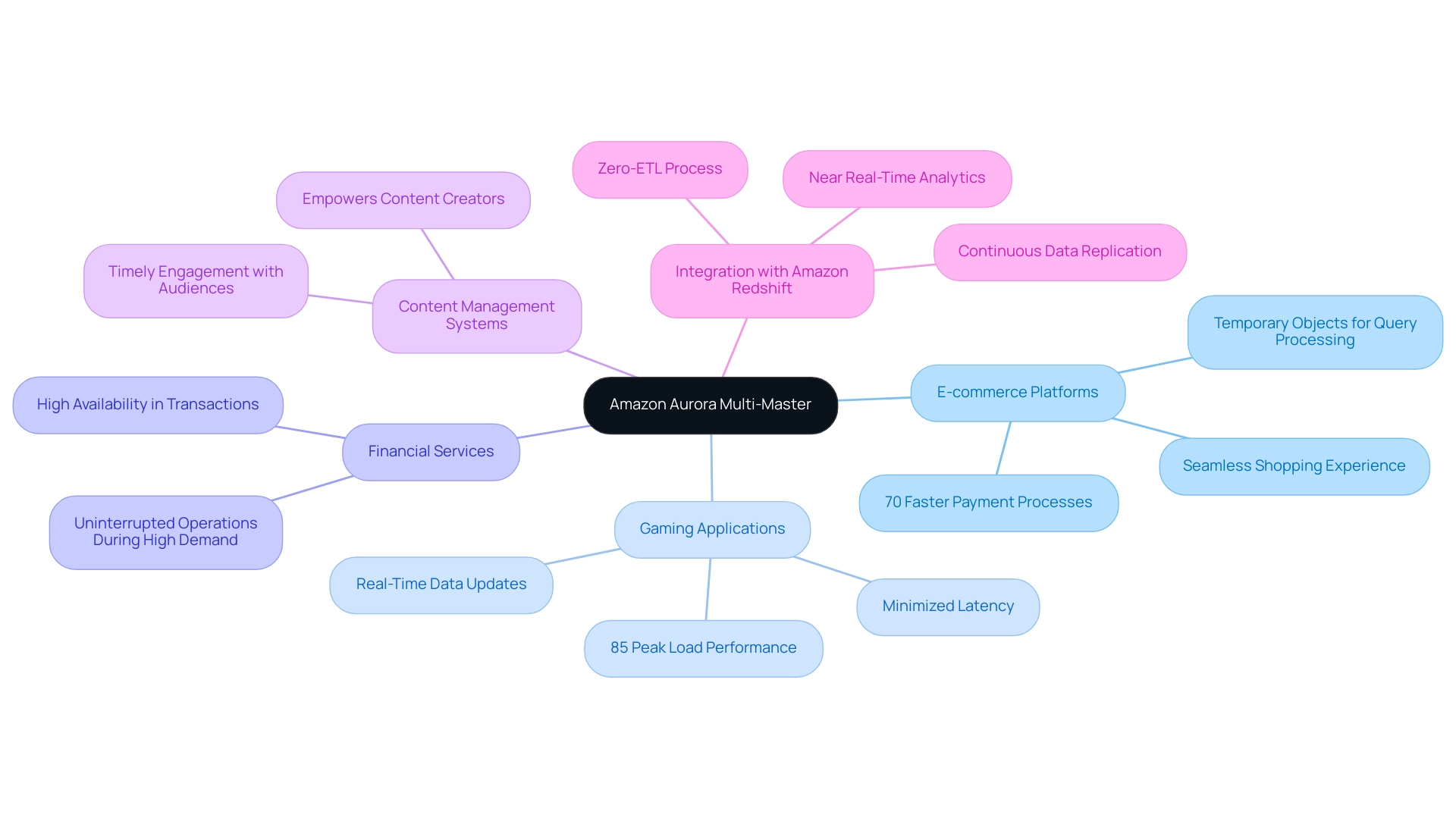
Conclusion
The exploration of Amazon Aurora Multi-Master reveals its significant role in enhancing database management strategies for modern enterprises. By enabling multiple database instances to execute concurrent read and write operations, organizations can achieve unparalleled levels of availability and scalability. The advantages of reduced latency and increased throughput are particularly beneficial for high-demand applications, as demonstrated by real-world case studies across various industries.
In addition to its numerous benefits, such as automatic failover and simplified management, the implementation of best practices is crucial for maximizing the effectiveness of Multi-Master configurations. Developers must:
- Design for conflict resolution
- Monitor performance metrics
- Conduct regular failover testing
to ensure the reliability and integrity of their applications. Addressing common challenges proactively, including write conflicts and increased complexity, further enhances the operational efficiency of Aurora Multi-Master.
As businesses continue to leverage the capabilities of Amazon Aurora, it is evident that this innovative architecture is poised to play a critical role in shaping the future of cloud database solutions. By adopting Multi-Master, organizations can not only optimize performance but also ensure that their applications can scale effectively in response to evolving demands. Embracing this technology will empower enterprises to stay ahead in an increasingly competitive landscape, making Amazon Aurora Multi-Master an indispensable asset for those seeking operational excellence and superior user experiences.




